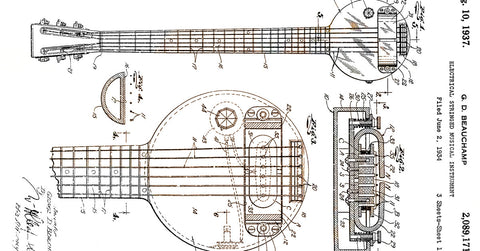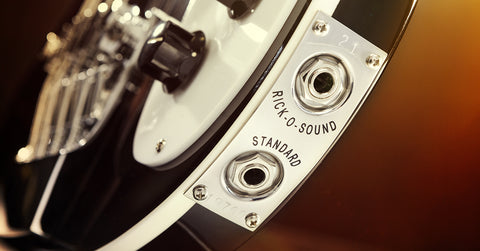The Invention Of The Electric Guitar
Rickenbacker guitars are known for their unique and distinctive sound, which has been loved by many famous musicians throughout history. The Rickenbacker story began in the early 1930s when Adolph Rickenbacker and George Beauchamp designed and built the world's first electric guitar. The guitar was called the "Frying Pan" because of its shape, and it revolutionized the music industry by enabling guitarists to amplify their sound and play with greater volume and sustain.

The construction of the Frying Pan was unique for its time, featuring a metal body that was made of aluminum and a neck that was made of Bakelite, a type of plastic. This construction allowed the guitar to be lightweight, durable, and resistant to feedback, all key considerations when designing an electric guitar.
One of the most significant aspects of the Frying Pan's design was the use of a single-coil pickup, which was mounted on the guitar's body. The pickup was specially designed to capture the vibrations of the strings and convert them into an electrical signal, which could then be amplified by an external amplifier. This allowed guitarists to play at higher volumes and with greater sustain, making it possible for them to be heard in larger venues.
These construction aspects of the Rickenbacker Frying Pan guitar were crucial to its success as the world's first electric guitar. The guitar's lightweight, durable, and feedback-resistant body, combined with its specially designed single-coil pickup and elevated fretboard, made it both playable and innovative. The Frying Pan's design set the standard for modern electric guitars, and its legacy can still be felt in the guitars we play today.

The Rick-O-Sound Innovation

Over the years, Rickenbacker has continued to innovate and create iconic guitars that have been played by many famous musicians. Rickenbacker guitars have a unique sound that is characterized by their high-end chime, warm midrange, and tight bass. One of the things that makes Rickenbacker guitars so unique is their use of a "Rick-O-Sound" stereo output, which enables guitarists to split their signal into two separate outputs, allowing them to process the high and low frequencies separately.
This innovation was first introduced in the early 1960s and has become a signature feature of Rickenbacker guitars ever since.
Originally, the Rick-O-Sound output was intended to be used with two separate amplifiers. One output would be sent to a regular guitar amplifier, while the other output would be sent to a dedicated bass amplifier. This allowed guitarists to create a full sound with both high and low frequencies, making it particularly useful for bands without a dedicated bass player.
One of the main advantages of the Rick-O-Sound output is the ability to create a unique and complex sound that is difficult to replicate with other guitars. By splitting the signal, guitarists can create a wide range of tonal variations that are not possible with a traditional mono output. This makes the Rick-O-Sound output particularly useful for recording, where guitarists can experiment with different sound combinations to create a more nuanced sound.
However, there are also some downsides to the Rick-O-Sound output. One of the main issues is that it can be difficult to find two amplifiers that are well-matched in terms of tone and volume. This can result in an unbalanced sound that can be difficult to control, particularly in a live performance setting.
Another potential downside is the increased cost and complexity of setting up a stereo rig. Guitarists will need to purchase two amplifiers and potentially additional effects pedals or signal processors, which can add up to a significant cost. Additionally, the increased number of cables and connections required for a stereo setup can increase the risk of technical issues, such as noise or signal loss.
Despite these potential downsides, the Rick-O-Sound output remains a unique and innovative feature of Rickenbacker guitars. It has been used by countless famous musicians over the years, including The Beatles, The Byrds, and Tom Petty, among others. For guitarists looking to create a complex and nuanced sound, the Rick-O-Sound output remains an essential tool in their arsenal.

The Ricky Models
Some of the most popular Rickenbacker guitar models include the 330, 360, and 4003 bass. The 330 is a semi-hollow body guitar with a distinctive "R" tailpiece, while the 360 is a solid body guitar that features a "cresting wave" body shape. The 4003 bass is a classic Rickenbacker design that has been used by countless bass players over the years.
The Ricky Colours
Rickenbacker guitars are also known for their unique and distinctive colors, which are an integral part of their iconic design. Some of the most popular Rickenbacker colors include Fireglo, Jetglo, and Mapleglo. Fireglo is a shimmering blend of red and gold that is often associated with Rickenbacker guitars, while Jetglo is a deep black that gives the guitars a classic and timeless look. Mapleglo is a natural wood finish that highlights the beauty of the guitar's grain and adds a touch of elegance to the design.

In conclusion, Rickenbacker guitars are a true icon in the world of music, with a rich history and a unique sound that has been loved by countless musicians over the years. From their early beginnings as the inventors of the first electric guitar to their current lineup of iconic designs, Rickenbacker guitars continue to inspire and delight guitarists around the world. Whether you are a seasoned professional or a beginner, a Rickenbacker guitar is sure to deliver a unique and unforgettable playing experience.
Written by:
Ryan Havinga







